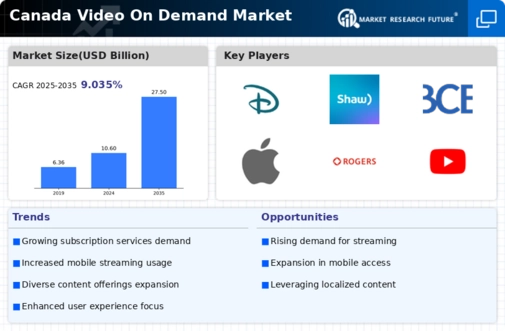The video on-demand market in Canada exhibits a dynamic competitive landscape, characterized by rapid technological advancements and shifting consumer preferences. Key players such as Netflix (US), Amazon Prime Video (US), and Disney+ (US) are at the forefront, each employing distinct strategies to capture market share. Netflix (US) continues to innovate with its content offerings, focusing on original programming and localized content to enhance viewer engagement. Meanwhile, Amazon Prime Video (US) leverages its extensive ecosystem, integrating video services with its e-commerce platform to provide a seamless user experience. Disney+ (US), on the other hand, capitalizes on its vast library of beloved franchises, positioning itself as a family-friendly alternative in a crowded market. Collectively, these strategies contribute to a competitive environment that is increasingly defined by content quality and user experience.
The business tactics employed by these companies reflect a nuanced understanding of market demands. For instance, localizing content and optimizing supply chains are critical for enhancing service delivery and customer satisfaction. The market structure appears moderately fragmented, with several players vying for dominance, yet the influence of major companies remains substantial. This competitive dynamic fosters innovation and drives companies to continuously refine their offerings, ensuring that they remain relevant in an ever-evolving landscape.
In October 2025, Netflix (US) announced a strategic partnership with a Canadian production studio to create exclusive content tailored for the Canadian audience. This move not only strengthens Netflix's local presence but also enhances its content library, making it more appealing to Canadian subscribers. The partnership signifies a commitment to regional content creation, which is likely to resonate well with local viewers and could potentially increase subscriber retention rates.
In September 2025, Amazon Prime Video (US) expanded its service offerings by introducing a new tier that includes live sports streaming. This strategic addition aims to attract a broader audience, particularly sports enthusiasts who are increasingly turning to streaming platforms for live events. By diversifying its content portfolio, Amazon Prime Video (US) positions itself as a comprehensive entertainment solution, which may enhance its competitive edge in the market.
In August 2025, Disney+ (US) launched an innovative interactive feature that allows viewers to engage with content in real-time, enhancing the viewing experience. This initiative reflects a growing trend towards interactivity in digital media, suggesting that Disney+ (US) is keen on leveraging technology to differentiate itself from competitors. Such advancements may not only attract new subscribers but also foster deeper engagement among existing users, thereby solidifying its market position.
As of November 2025, the competitive trends in the video on-demand market are increasingly shaped by digitalization, sustainability, and the integration of artificial intelligence. Strategic alliances are becoming more prevalent, as companies recognize the value of collaboration in enhancing content offerings and technological capabilities. Looking ahead, competitive differentiation is likely to evolve, with a shift from price-based competition towards innovation, technology, and supply chain reliability. This transition underscores the importance of delivering unique value propositions that resonate with consumers, ultimately shaping the future of the video on-demand landscape.



















Leave a Comment